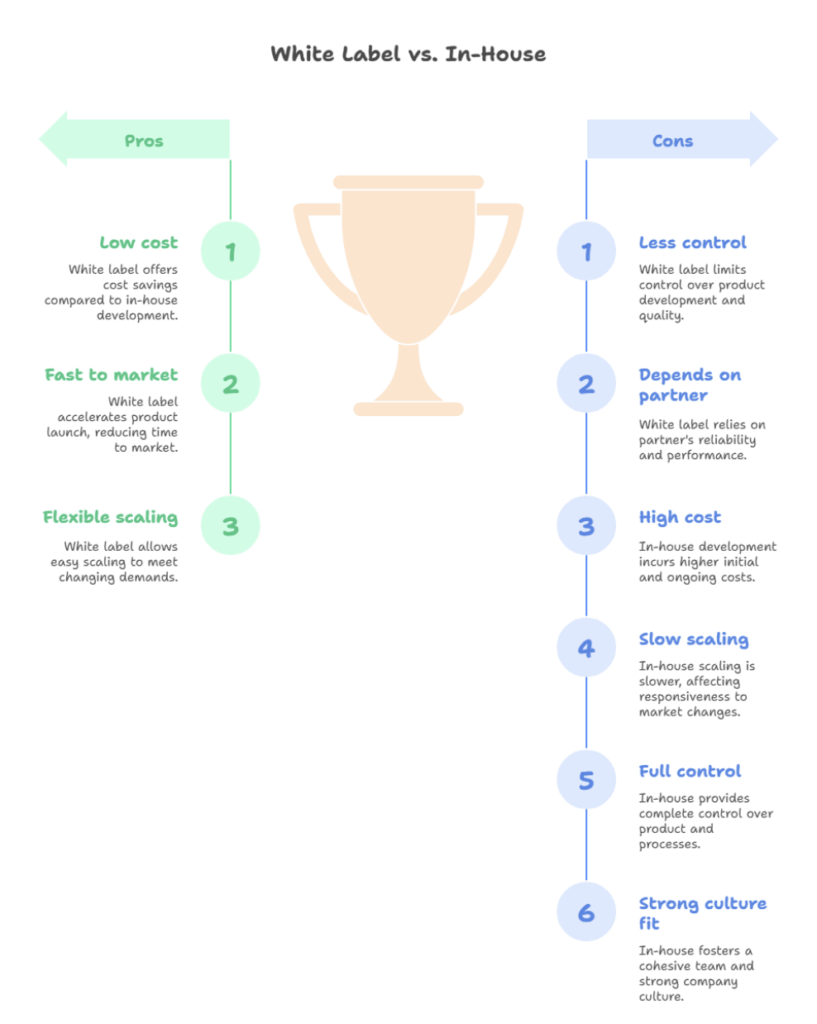Every growing digital marketing agency reaches a pivotal moment: how do you deliver more services without compromising quality, profitability, or client trust? Should you hire employees in-houseor use white label partners?
Choosing the right path can be the difference between thriving growth and stalled momentum.
Contents: White Label vs. In-House Hiring Guide
Why Choosing the Right Model Matters
In today’s competitive US market:
- Clients expect a full range of services.
- Competitors are expanding quickly.
- Margins are under pressure with rising salaries and benefits costs.
How you staff your agency affects not just profit, but:
- Service quality
- Scalability
- Speed to market
- Client retention
- Long-term sustainability
What Is White Labeling?
White labeling means partnering with a specialized provider who works behind the scenes, delivering services under your brand. This lets you expand your offerings quickly—without hiring employees or training teams.
Example: You close a client for SEO → your white label partner handles strategy, implementation, reporting → you deliver results as if your agency did the work.
What Does Hiring In-House Mean?
Hiring in-house means adding employees to your payroll—full-time team members who work exclusively for your agency. You’re responsible for:
- Recruitment
- Salaries & benefits
- Equipment
- Training & development
- Performance management
Detailed Comparison:
White Label vs. In-House

Pros & Cons of White Labeling
Pros
- Quickly expand your service offerings
- Control overhead by avoiding fixed salaries
- Access experts in many fields
- Focus your team on strategy & client relationships
- Flexibility: add or drop services as client demands shift
Cons
- Less day-to-day control of execution
- Potential quality inconsistency without clear processes
- Brand risk if the provider isn’t reliable
- Communication challenges if not aligned on expectations
Pros & Cons of Hiring In-House
Pros
- Full control over quality, processes, and timelines
- Employees can fully absorb your agency culture
- Direct, fast communication within your team
- Stronger relationships and loyalty
Cons
- High fixed costs, even during slow periods
- Recruitment and training take significant time and resources
- Limited expertise—you can’t afford specialists in every area
- Greater financial risk during downturns
Key Factors to Help You Decide
Ask yourself:
- How predictable is your agency’s cash flow?
- Do you need to deliver complex, proprietary services requiring tight control?
- Do you expect seasonal fluctuations in demand?
- Is your agency culture built around team cohesion or flexibility?
- Do you plan to scale nationally or stay boutique?
- How quickly do your clients expect new services?
- Are you prepared to handle HR, payroll, and compliance responsibilities?
Real-World Agency Scenarios
Scenario 1: Startups & Young Agencies
A 2-person agency wants to add social media marketing. Hiring an employee costs $50K–$70K/year + benefits. Using a white label provider allows instant delivery, minimal cost, and less risk.
Best choice:White labeling.
Scenario 2: Mid-Sized Agency with Predictable Retainers
A 15-person agency with stable monthly revenue wants to own delivery fully and protect its proprietary processes.
Best choice:Hiring in-house (or hybrid).
Scenario 3: Rapidly Growing Agency
An agency adding multiple new clients per month needs SEO, PPC, and web design to keep up.
Best choice:White label partners to handle demand spikes.
How to Transition to a New Model
Review your finances– project cash flow and capacity.
Survey your clients– identify service gaps you could fill.
Choose your model– white label, in-house, or hybrid.
Pilot your choice– start with 1-2 clients before full rollout.
Evaluate results– measure cost, quality, and client satisfaction.
Adjust as needed– your approach can evolve as your agency grows.
Conclusion
Whether you choose white label partners, hiring in-house, or a hybrid, the best path is the one aligning with your agency’s goals, clients’ expectations, and your appetite for risk.
In most cases, a flexible strategy—starting with white label and hiring selectively—lets growing agencies scale faster and more profitably.
Ready to expand your services with reliable white label support?
Book a Free Strategy Call Todayor call us at +1 562-512-7138
Let’s build a scalable model together—so your agency can grow with confidence.
FAQ
FAQ: Common Questions Agency Owners Ask
Yes—many agencies start with white labeling to test service demand. Once they have stable revenue, they selectively hire in-house for core services.
Vet your providers carefully, establish clear SLAs, create shared SOPs, and regularly review deliverables.
Absolutely—most agencies white label services outside their core expertise while keeping key offerings in-house.
Both can deliver strong client experiences if managed well. In-house gives you direct control; white labeling requires strong communication to ensure alignment.
A full-time marketing hire in the US costs ~$60K–$90K/year plus 20–30% for benefits. White label services typically cost 20–50% less on average, billed per project or monthly retainer.
No—quality white label providers offer 100% branded deliverables, so your clients never see the provider’s name.

